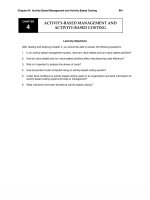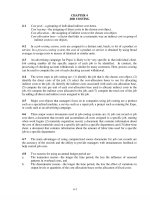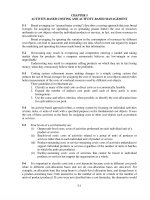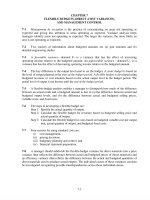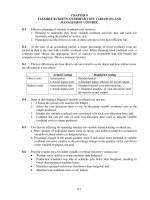Solution manual cost accounting 14e by horngren chapter 04
Bạn đang xem bản rút gọn của tài liệu. Xem và tải ngay bản đầy đủ của tài liệu tại đây (985.97 KB, 47 trang )
To download more slides, ebook, solutions and test bank, visit
CHAPTER 4
JOB COSTING
4-1
Cost pool––a grouping of individual indirect cost items.
Cost tracing––the assigning of direct costs to the chosen cost object.
Cost allocation––the assigning of indirect costs to the chosen cost object.
Cost-allocation base––a factor that links in a systematic way an indirect cost or group of
indirect costs to cost objects.
4-2
In a job-costing system, costs are assigned to a distinct unit, batch, or lot of a product or
service. In a process-costing system, the cost of a product or service is obtained by using broad
averages to assign costs to masses of identical or similar units.
4-3
An advertising campaign for Pepsi is likely to be very specific to that individual client.
Job costing enables all the specific aspects of each job to be identified. In contrast, the
processing of checking account withdrawals is similar for many customers. Here, process costing
can be used to compute the cost of each checking account withdrawal.
4-4
The seven steps in job costing are: (1) identify the job that is the chosen cost object, (2)
identify the direct costs of the job, (3) select the cost-allocation bases to use for allocating
indirect costs to the job, (4) identify the indirect costs associated with each cost-allocation base,
(5) compute the rate per unit of each cost-allocation base used to allocate indirect costs to the
job, (6) compute the indirect costs allocated to the job, and (7) compute the total cost of the job
by adding all direct and indirect costs assigned to the job.
4-5
Major cost objects that managers focus on in companies using job costing are a product
such as a specialized machine, a service such as a repair job, a project such as running the Expo,
or a task such as an advertising campaign.
4-6
Three major source documents used in job-costing systems are (1) job cost record or job
cost sheet, a document that records and accumulates all costs assigned to a specific job, starting
when work begins (2) materials requisition record, a document that contains information about
the cost of direct materials used on a specific job and in a specific department; and (3) labor-time
sheet, a document that contains information about the amount of labor time used for a specific
job in a specific department.
4-7
The main advantages of using computerized source documents for job cost records are
the accuracy of the records and the ability to provide managers with instantaneous feedback to
help control job costs.
4-8
a.
b.
Two reasons for using an annual budget period are
The numerator reason––the longer the time period, the less the influence of seasonal
patterns in overhead costs, and
The denominator reason––the longer the time period, the less the effect of variations in
output levels or quantities of the cost-allocation bases on the allocation of fixed costs.
4-1
To download more slides, ebook, solutions and test bank, visit
4-9
Actual costing and normal costing differ in their use of actual or budgeted indirect cost
rates:
Actual
Normal
Costing
Costing
Direct-cost rates
Actual rates
Actual rates
Indirect-cost rates
Actual rates
Budgeted rates
Each costing method uses the actual quantity of the direct-cost input and the actual quantity of
the cost-allocation base.
4-10 A house construction firm can use job cost information (a) to determine the profitability
of individual jobs, (b) to assist in bidding on future jobs, and (c) to evaluate professionals who
are in charge of managing individual jobs.
4-11 The statement is false. In a normal costing system, the Manufacturing Overhead Control
account will not, in general, equal the amounts in the Manufacturing Overhead Allocated
account. The Manufacturing Overhead Control account aggregates the actual overhead costs
incurred while Manufacturing Overhead Allocated allocates overhead costs to jobs on the basis
of a budgeted rate times the actual quantity of the cost-allocation base.
Underallocation or overallocation of indirect (overhead) costs can arise because of (a) the
Numerator reason––the actual overhead costs differ from the budgeted overhead costs, and (b)
the Denominator reason––the actual quantity used of the allocation base differs from the
budgeted quantity.
4-12 Debit entries to Work-in-Process Control represent increases in work in process.
Examples of debit entries under normal costing are (a) direct materials used (credit to Materials
Control), (b) direct manufacturing labor billed to job (credit to Wages Payable Control), and (c)
manufacturing overhead allocated to job (credit to Manufacturing Overhead Allocated).
4-13 Alternative ways to make end-of-period adjustments to dispose of underallocated or
overallocated overhead are as follows:
(i) Proration based on the total amount of indirect costs allocated (before proration) in
the ending balances of work in process, finished goods, and cost of goods sold.
(ii) Proration based on total ending balances (before proration) in work in process,
finished goods, and cost of goods sold.
(iii) Year-end write-off to Cost of Goods Sold.
(iv) The adjusted allocation rate approach that restates all overhead entries using actual
indirect cost rates rather than budgeted indirect cost rates.
4-14 A company might use budgeted costs rather than actual costs to compute direct labor
rates because it may be difficult to trace direct labor costs to jobs as they are completed (for
example, because bonuses are only known at the end of the year).
4-15 Modern technology of electronic data interchange (EDI) is helpful to managers because it
ensures that a purchase order is transmitted quickly and accurately to suppliers with minimum
paperwork and costs.
4-2
To download more slides, ebook, solutions and test bank, visit
4-16
a.
b.
c.
d.
e.
f.
g.
h.
i.
j.
k.
(10 min) Job order costing, process costing.
Job costing
Process costing
Job costing
Process costing
Job costing
Process costing
Job costing
Job costing (but some process costing)
Process costing
Process costing
Job costing
l.
m.
n.
o.
p.
q.
r.
s.
t.
u.
4-3
Job costing
Process costing
Job costing
Job costing
Job costing
Job costing
Process costing
Job costing
Process costing
Job costing
To download more slides, ebook, solutions and test bank, visit
4-17
1.
(20 min.) Actual costing, normal costing, accounting for manufacturing overhead.
Budgeted manufacturing
overhead rate
Actual manufactur ing
overhead rate
=
Budgeted manufactur ing
overhead costs
Budgeted direct manufactur ing
labor costs
=
$2, 700, 000
= 1.80 or 180%
$1,500, 000
=
Actual manufactur ing
overhead costs
Actual direct manufactur ing
labor costs
$2, 755, 000
= 1.9 or 190%
$1, 450, 000
Costs of Job 626 under actual and normal costing follow:
=
2.
Actual
Costing
Direct materials
Direct manufacturing labor costs
Manufacturing overhead costs
$30,000 1.90; $30,000 1.80
Total manufacturing costs of Job 626
3.
Total manufacturing overhead
allocated under normal costing =
$ 40,000
30,000
$ 40,000
30,000
57,000
$127,000
54,000
$124,000
Actual manufacturing
labor costs
= $1,450,000
Normal
Costing
Budgeted
overhead rate
1.80
= $2,610,000
Underallocated manufacturing =
overhead
Actual manufacturing – Manufacturing
overhead costs
overhead allocated
= $2,755,000
$2,610,000 = $145,000
There is no under- or overallocated overhead under actual costing because overhead is
allocated under actual costing by multiplying actual manufacturing labor costs and the actual
manufacturing overhead rate. This, of course equals the actual manufacturing overhead costs. All
actual overhead costs are allocated to products. Hence, there is no under- or overallocated
overhead.
4-4
To download more slides, ebook, solutions and test bank, visit
4-18
1.
(20 -30 min.) Job costing, normal and actual costing.
Budgeted indirectcost rate
=
Budgeted indirect costs (assembly support)
$8,300,000
=
Budgeted direct labor-hours
166,000 hours
= $50 per direct labor-hour
Actual indirectcost rate
=
$6,520,000
Actual indirect costs (assembly support)
=
163,000 hours
Actual direct labor-hours
= $40 per direct labor-hour
These rates differ because both the numerator and the denominator in the two calculations are
different—one based on budgeted numbers and the other based on actual numbers.
2a.
Laguna
Model
Normal costing
Direct costs
Direct materials
Direct labor
Indirect costs
Assembly support ($50
Total costs
2b. Actual costing
Direct costs
Direct materials
Direct labor
Indirect costs
Assembly support ($40
Total costs
960; $50
960; $40
1,050)
1,050)
Mission
Model
$106,760
36,950
143,710
$127,550
41,320
168,870
48,000
$191,710
52,500
$221,370
$106,760
36,950
143,710
$127,550
41,320
168,870
38,400
$182,110
42,000
$210,870
3.
Normal costing enables Amesbury to report a job cost as soon as the job is completed,
assuming that both the direct materials and direct labor costs are known at the time of use. Once
the 960 direct labor-hours are known for the Laguna Model (June 2011), Amesbury can compute
the $191,710 cost figure using normal costing. Amesbury can use this information to manage the
costs of the Laguna Model job as well as to bid on similar jobs later in the year. In contrast,
Amesbury has to wait until the December 2011 year-end to compute the $182,110 cost of the
Laguna Model using actual costing.
Although not required, the following overview diagram summarizes Amesbury
Construction’s job-costing system.
4-5
To download more slides, ebook, solutions and test bank, visit
INDIRECT
COST
POOL
Assembly
Support
COST
ALLOCATION
BASE
Direct
Labor-Hours
COST OBJECT:
RESIDENTIAL
HOME
Indirect Costs
Direct Costs
DIRECT
COSTS
Direct
Materials
4-6
Direct
Manufacturing
Labor
To download more slides, ebook, solutions and test bank, visit
4-19
(10 min.) Budgeted manufacturing overhead rate, allocated manufacturing overhead.
1.
Budgeted manufacturing overhead rate =
=
2.
Manufacturing
overhead
allocated
=
Budgeted manufacturing overhead
Budgeted machine hours
$4, 200, 000
= $24 per machine-hour
175, 000 machine-hours
Actual
machine-hours
Budgeted
manufacturing
overhead rate
= 170,000 × $24 = $4,080,000
3.
Since manufacturing overhead allocated is greater than the actual manufacturing overhead
costs, Gammaro overallocated manufacturing overhead:
Manufacturing overhead allocated
Actual manufacturing overhead costs
Overallocated manufacturing overhead
4-7
$4,080,000
4,050,000
$ 30,000
To download more slides, ebook, solutions and test bank, visit
4-20
(20-30 min.) Job costing, accounting for manufacturing overhead, budgeted rates.
1.
An overview of the product costing system is
INDIRECT
COST
POOL
COST
ALLOCATION
BASE
Machining Department
Manufacturing Overhead
Assembly Department
Manufacturing Overhead
Machine-Hours
Indirect Costs
COST OBJECT:
PRODUCT
DIRECT
COST
Direct Manuf.
Labor Cost
Direct Costs
Direct
Manufacturing
Labor
Direct
Materials
Budgeted manufacturing overhead divided by allocation base:
Machining overhead:
Assembly overhead:
2.
$1,800 ,000
= $36 per machine-hour
50,000
$3,600 ,000
= 180% of direct manuf. labor costs
$2,000 ,000
Machining department, 2,000 hours $36
Assembly department, 180% $15,000
Total manufacturing overhead allocated to Job 494
3.
$72,000
27,000
$99,000
Machining
Assembly
$2,100,000
$ 3,700,000
Actual manufacturing overhead
Manufacturing overhead allocated,
$36 55,000 machine-hours
180% $2,200,000
Underallocated (Overallocated)
1,980,000
—
$ 120,000
4-8
—
3,960,000
$ (260,000)
To download more slides, ebook, solutions and test bank, visit
4-21
(20 25 min.) Job costing, consulting firm.
1.
Budgeted indirect-cost rate for client support can be calculated as follows:
Budgeted indirect-cost rate = $13,600,000 ÷ $5,312,500 = 256% of professional labor costs
INDIRECT
COST
POOL
Client
Consulting
Consulting
Support
Support
COST
ALLOCATION
BASE
Professional
Professional
Labor
LaborCosts
Costs
COST OBJECT:
JOB FOR
CONSULTING
CLIENT
Indirect Costs
Direct Costs
DIRECT
COSTS
2.
Professional
Labor
At the budgeted revenues of $21,250,000 Taylor’s operating income of $2,337,500
equals 11% of revenues.
Markup rate = $21,250,000 ÷ $5,312,500 = 400% of direct professional labor costs
4-9
To download more slides, ebook, solutions and test bank, visit
3.
Budgeted costs
Direct costs:
Director, $198 4
$ 792
Partner, $101 17
1,717
Associate, $49 42
2,058
Assistant, $36 153
5,508
Indirect costs:
Consulting support, 256% $10,075
Total costs
$10,075
25,792
$35,867
As calculated in requirement 2, the bid price to earn an 11% income-to-revenue margin is 400%
of direct professional costs. Therefore, Taylor should bid 4 $10,075 = $40,300 for the Red
Rooster job.
Bid price to earn target operating income-to-revenue margin of 11% can also be
calculated as follows:
Let R = revenue to earn target income
R – 0.11R = $35,867
0.89R = $35,867
R = $35,867 ÷ 0.89 = $40,300
Or
Direct costs
Indirect costs
Operating income (0.11
Bid price
$40,300)
4-10
$10,075
25,792
4,433
$40,300
To download more slides, ebook, solutions and test bank, visit
4-22
(15–20 min.) Time period used to compute indirect cost rates.
1.
(1)
(2)
(3)
(4)
Pools sold
Direct manufacturing
labor hours (0.5 Row 1)
Fixed manufacturing
overhead costs
Budgeted fixed
manufacturing overhead
rate per direct
manufacturing labor hour
($10,500 Row 2)
Quarter
3
150
1
700
2
500
350
250
$10,500
$10,500
$30
$42
Direct material costs ($7.50 500 pools; 150 pools)
Direct manufacturing labor costs
($16 250 hours; 75 hours)
Variable manufacturing overhead costs
($12 250 hours; 75 hours)
Fixed manufacturing overhead costs
($42 250 hours; $140 × 75 hours)
Total manufacturing costs
Divided by pools manufactured each quarter
Manufacturing cost per pool
75
$10,500
$140
4
150
Annual
1,500
75
750
$10,500
$140
$56
Budgeted Costs Based on
Quarterly Manufacturing
Overhead Rate
nd
2 Quarter
3rd Quarter
$ 3,750
$ 1,125
4,000
3,000
10,500
$21,250
÷ 500
$ 42.50
1,200
900
10,500
$13,725
÷ 150
$ 91.50
2.
Direct material costs ($7.50 500 pools; 150 pools)
Direct manufacturing labor costs
($16 250 hours; 75 hours)
Variable manufacturing overhead costs
($12 250 hours; 75 hours)
Fixed manufacturing overhead costs
($56 250 hours; 75 hours)
Total manufacturing costs
Divided by pools manufactured each quarter
Manufacturing cost per pool
4-11
Budgeted Costs Based on
Annual Manufacturing
Overhead Rate
2nd Quarter
3rd Quarter
$ 3,750
$1,125
4,000
3,000
14,000
$24,750
500
$ 49.50
$42,000
1,200
900
4,200
$7,425
150
$49.50
To download more slides, ebook, solutions and test bank, visit
3.
Prices based on quarterly budgeted manufacturing
overhead rates calculated in requirement 1
($42.50 130%; $91.50 130%)
Price based on annual budgeted manufacturing overhead
rates calculated in requirement 2
($49.50 130%; $49.50 130%)
2nd Quarter
3rd Quarter
$55.25
$118.95
$64.35
$64.35
Splash should use the budgeted annual manufacturing overhead rate because capacity decisions
are based on longer annual periods rather than quarterly periods. Prices should not vary based on
quarterly fluctuations in production. Splash could vary prices based on market conditions and
demand for its pools. In this case, Splash would charge higher prices in quarter 2 when demand
for its pools is high. Pricing based on quarterly budgets would cause Splash to do the opposite—
to decrease rather than increase prices!
4-12
To download more slides, ebook, solutions and test bank, visit
4-23
1.
(10–15 min.) Accounting for manufacturing overhead.
Budgeted manufacturing overhead rate =
$7,500, 000
250,000 machine-hours
= $30 per machine-hour
2.
Work-in-Process Control
Manufacturing Overhead Allocated
(245,000 machine-hours $30 per machine-hour = $7,350,000)
7,350,000
7,350,000
3. $7,350,000– $7,300,000 = $50,000 overallocated,
an insignificant amount of actual manufacturing overhead
costs $50,000 ÷ $7,300,000 = 0.68%.
Manufacturing Overhead Allocated
Manufacturing Department Overhead Control
Cost of Goods Sold
4-13
7,350,000
7,300,000
50,000
To download more slides, ebook, solutions and test bank, visit
4-24
(35 45 min.) Job costing, journal entries.
Some instructors may also want to assign Exercise 4-25. It demonstrates the relationships of the
general ledger to the underlying subsidiary ledgers and source documents.
1.
An overview of the product costing system is:
INDIRECT
COST
POOL
COST
ALLOCATION
BASE
Manufacturing Overhead
Direct Manufacturing
Labor Costs
Indirect Costs
COST OBJECT:
PRINT JOB
DIRECT
COST
Direct Costs
Direct
Materials
4-14
Direct
Manuf.
Labor
To download more slides, ebook, solutions and test bank, visit
2. & 3.
This answer assumes COGS given of $4,020 does not include the writeoff of overallocated
manufacturing overhead.
2.
(1) Materials Control
Accounts Payable Control
(2) Work-in-Process Control
Materials Control
(3) Manufacturing Overhead Control
Materials Control
(4) Work-in-Process Control
Manufacturing Overhead Control
Wages Payable Control
(5) Manufacturing Overhead Control
Accumulated Depreciation––buildings and
manufacturing equipment
(6) Manufacturing Overhead Control
Miscellaneous accounts
(7) Work-in-Process Control
Manufacturing Overhead Allocated
(1.60 $1,300 = $2,080)
(8) Finished Goods Control
Work-in-Process Control
(9) Accounts Receivable Control (or Cash)
Revenues
(10) Cost of Goods Sold
Finished Goods Control
(11) Manufacturing Overhead Allocated
Manufacturing Overhead Control
Cost of Goods Sold
4-15
800
800
710
710
100
100
1,300
900
2,200
400
400
550
550
2,080
2,080
4,120
4,120
8,000
8,000
4,020
4,020
2,080
1,950
130
To download more slides, ebook, solutions and test bank, visit
3.
Bal. 1/1/2011
(1) Accounts Payable
Control (Purchases)
Bal. 12/31/2011
Bal. 1/1/2011
(2) Materials Control
(Direct materials)
(4) Wages Payable
Control (Direct
manuf. labor)
(7) Manuf. Overhead
Allocated
Bal. 12/31/2011
Bal. 1/1/2011
(8) WIP Control
(Goods completed)
Bal. 12/31/2011
(10) Finished Goods
Control (Goods sold)
Bal. 12/31/2011
Materials Control
100 (2) Work-in-Process Control
(Materials used)
800 (3) Manufacturing Overhead
Control (Materials used)
90
Work-in-Process Control
60 (8) Finished Goods Control
(Goods completed)
710
100
4,120
1,300
2,080
30
Finished Goods Control
500 (10) Cost of Goods Sold
4,020
4,120
600
Cost of Goods Sold
(11) Manufacturing Overhead
4,020
Allocated (Adjust for
overallocation)
3,890
Manufacturing Overhead Control
(3) Materials Control
(11) To close
(Indirect materials)
100
(4) Wages Payable Control
(Indirect manuf. labor)
900
(5) Accum. Deprn. Control
(Depreciation)
400
(6) Accounts Payable Control
(Miscellaneous)
550
Bal.
0
(11) To close
710
Manufacturing Overhead Allocated
2,080 (7) Work-in-Process Control
(Manuf. overhead allocated)
Bal.
4-16
130
1,950
2,080
0
To download more slides, ebook, solutions and test bank, visit
4-25
(35 minutes) Journal entries, T-accounts, and source documents.
1.
i. Direct Materials Control
124,000
Accounts Payable Control
Source Document: Purchase Invoice, Receiving Report
Subsidiary Ledger: Direct Materials Record, Accounts Payable
124,000
ii. Work in Process Control a
122,000
Direct Materials Control
122,000
Source Document: Material Requisition Records, Job Cost Record
Subsidiary Ledger: Direct Materials Record, Work-in-Process Inventory Records by Jobs
iii. Work in Process Control
80,000
Manufacturing Overhead Control
54,500
Wages Payable Control
134,500
Source Document: Labor Time Sheets, Job Cost Records
Subsidiary Ledger:, Manufacturing Overhead Records, Employee Labor Records, Work-inProcess Inventory Records by Jobs
iv. Manufacturing Overhead Control
129,500
Salaries Payable Control
20,000
Accounts Payable Control
9,500
Accumulated Depreciation Control
30,000
Rent Payable Control
70,000
Source Document: Depreciation Schedule, Rent Schedule, Maintenance wages due, Invoices
for miscellaneous factory overhead items
Subsidiary Ledger: Manufacturing Overhead Records
v. Work in Process Control
200,000
Manufacturing Overhead Allocated
($80,000 $2.50)
Source Document: Labor Time Sheets, Job Cost Record
Subsidiary Ledger: Work-in-Process Inventory Records by Jobs
200,000
vi. Finished Goods Control b
387,000
Work in Process Control
387,000
Source Document: Job Cost Record, Completed Job Cost Record
Subsidiary Ledger: Work-in-Process Inventory Records by Jobs, Finished Goods Inventory
Records by Jobs
vii. Cost of Goods Sold c
432,000
Finished Goods Control
Source Document: Sales Invoice, Completed Job Cost Record
Subsidiary Ledger: Finished Goods Inventory Records by Jobs
4-17
432,000
To download more slides, ebook, solutions and test bank, visit
viii.
Manufacturing Overhead Allocated
Manufacturing Overhead Control
($129,500 + $54,500)
Cost of Goods Sold
Source Document: Prior Journal Entries
200,000
184,000
16,000
ix. Administrative Expenses
7,000
Marketing Expenses
120,000
Salaries Payable Control
30,000
Accounts Payable Control
90,000
Accumulated Depreciation, Office Equipment
7,000
Source Document: Depreciation Schedule, Marketing Payroll Request, Invoice for
Advertising, Sales Commission Schedule.
Subsidiary Ledger: Employee Salary Records, Administration Cost Records, Marketing Cost
Records.
a
Beginning direct
Ending direct
Materials used = materials inventory + Purchases – materials inventory
= $9,000 + $124,000
b
$11,000 = $122,000
Cost of
Beginning WIP
Ending WIP
+ Manufacturing – inventory
goods manufactured =
inventory
cost
= $6,000 + ($122,000 + $80,000 + $200,000)
c
$21,000 = $387,000
Beginning finished
Ending finished
Cost of goods sold = goods inventory + Cost of goods – goods inventory
manufactured
= $69,000 + $387,0000 $24,000 = $432,000
4-18
To download more slides, ebook, solutions and test bank, visit
2.
T-accounts
Bal. 1/1/2011
(1) Accounts Payable Control
(Purchases)
Bal. 12/31/2011
Bal. 1/1/2011
(2) Materials Control
(Direct materials used)
(3) Wages Payable Control
(Direct manuf. labor)
(5) Manuf. Overhead
Allocated
Bal. 12/31/2011
Bal. 1/1/2011
(6) WIP Control
(Cost of goods manuf.)
Bal. 12/31/2011
(7) Finished Goods Control
(Goods sold)
Direct Materials Control
9,000 (2) Work-in-Process Control
(Materials used)
124,000
11,000
Work-in-Process Control
6,000 (6) Finished Goods Control
(Cost of goods
122,000
manufactured)
387,000
80,000
200,000
21,000
Finished Goods Control
69,000 (7) Cost of Goods Sold
432,000
387,000
24,000
Cost of Goods Sold
(8) Manufacturing Overhead
432,000
Allocated (Adjust for
overallocation)
Manufacturing Overhead Control
(3) Wages Payable Control
(8) To close
(Indirect manuf. labor)
54,500
(4) Salaries Payable Control
(Maintenance)
20,000
(4) Accounts Payable Control
(Miscellaneous)
9,500
(4) Accum. Deprn. Control
(Depreciation)
30,000
(4) Rent Payable Control
(Rent)
70,000
Bal.
0
(8) To close
122,000
Manufacturing Overhead Allocated
200,000 (5) Work-in-Process Control
(Manuf. overhead
allocated)
Bal.
4-19
16,000
184,000
200,000
0
To download more slides, ebook, solutions and test bank, visit
4-26
(45 min.) Job costing, journal entries.
Some instructors may wish to assign Problem 4-24. It demonstrates the relationships of journal
entries, general ledger, subsidiary ledgers, and source documents.
1.
An overview of the product-costing system is
INDIRECT
COST
POOL
Manufacturing
Overhead
COST
ALLOCATION
BASE
Machine-Hours
Indirect Costs
Direct Costs
COST OBJECT
PRODUCT
DIRECT
COSTS
2.
(1)
(2)
(3)
(4)
(5)
(6)
(7)
(8)
(9)
(10a)
(10b)
Direct
Materials
Direct
Manuf. Labor
Amounts in millions.
Materials Control
Accounts Payable Control
Work-in-Process Control
Materials Control
Manufacturing Department Overhead Control
Materials Control
Work-in-Process Control
Wages Payable Control
Manufacturing Department Overhead Control
Wages Payable Control
Manufacturing Department Overhead Control
Accumulated Depreciation
Manufacturing Department Overhead Control
Various liabilities
Work-in-Process Control
Manufacturing Overhead Allocated
Finished Goods Control
Work-in-Process Control
Cost of Goods Sold
Finished Goods Control
Accounts Receivable Control (or Cash )
Revenues
4-20
150
150
145
145
10
10
90
90
30
30
19
19
9
9
63
63
294
294
292
292
400
400
To download more slides, ebook, solutions and test bank, visit
The posting of entries to T-accounts is as follows:
Bal
(1)
Bal.
Materials Control
12 (2)
150 (3)
7
Bal.
(9)
Bal.
Finished Goods Control
6 (10a)
294
8
(3)
(5)
(6)
(7)
Manufacturing Department
Overhead Control
10 (11)
30
19
9
(10b)
145
10
Bal.
(2)
(4)
(8)
Bal.
Work-in-Process Control
2 (9)
145
90
63
6
292
(10a)
(11)
Cost of Goods Sold
292
5
Manufacturing Overhead Allocated
(11)
63 (8)
63
68
Accounts Payable Control
(1)
150
Accumulated Depreciation
(6)
19
Accounts Receivable Control
400
Wages Payable Control
(4)
(5)
90
30
Various Liabilities
(7)
9
Revenues
(10b)
400
The ending balance of Work-in-Process Control is $6.
3.
294
(11) Manufacturing Overhead Allocated
Cost of Goods Sold
Manufacturing Department Overhead Control
Entry posted to T-accounts in Requirement 2.
4-21
63
5
68
To download more slides, ebook, solutions and test bank, visit
4-27
(15 min.)
Job costing, unit cost, ending work in progress.
1.
Direct manufacturing labor rate per hour
Manufacturing overhead cost allocated
per manufacturing labor-hour
Direct manufacturing labor costs
Direct manufacturing labor hours
($273,000 $26; $208,000 $26)
Manufacturing overhead cost allocated
(10,500 $20; 8,000 $20)
Job Costs May 2011
Direct materials
Direct manufacturing labor
Manufacturing overhead allocated
Total costs
$26
$20
Job M1
$273,000
Job M2
$208,000
10,500
8,000
$210,000
$160,000
Job M1
$ 78,000
273,000
210,000
$561,000
Job M2
$ 51,000
208,000
160,000
$419,000
2.
Number of pipes produced for Job M1
Cost per pipe ($561,000 1,100)
1,100
$510
3.
Finished Goods Control
Work-in-Process Control
561,000
561,000
4. Rafael Company began May 2011 with no work-in-process inventory. During May, it started
and finished M1. It also started M2, which is still in work-in-process inventory at the end of
May. M2’s manufacturing costs up to this point, $419,000, remain as a debit balance in the
Work-in-Process Inventory account at the end of May 2011.
4-22
To download more slides, ebook, solutions and test bank, visit
4-28
1.
(20 30 min.) Job costing; actual, normal, and variation from normal costing.
Actual direct cost rate for professional labor = $59 per professional labor-hour
$735,000
17,500 hours
= $42 per professional labor-hour
=
$990,000
18,000 hours
= $55 per professional labor-hour
Budgeted indirect cost rate =
$774,000
18,000 hours
= $43 per professional labor-hour
Actual indirect cost rate =
Budgeted direct cost rate
for professional labor
Direct-Cost Rate
Indirect-Cost Rate
2.
Direct Costs
Indirect Costs
Total Job Costs
(a)
(b)
Actual
Normal
Costing
Costing
$59
$59
(Actual rate)
(Actual rate)
$42
$43
(Actual rate) (Budgeted rate)
(c)
Variation of
Normal Costing
$55
(Budgeted rate)
$43
(Budgeted rate)
(a)
(b)
(c)
Actual
Normal
Variation of
Costing
Costing
Normal Costing
$59 160 = $ 9,440 $59 160 = $ 9,440 $55 160 = $ 8,800
$42 160 = 6,720 $43 160 = 6,880 $43 160 =
6,880
$16,160
$16,320
$15,680
All three costing systems use the actual professional labor time of 160 hours. The budgeted 150
hours for the Pierre Enterprises audit job is not used in job costing. However, Chico may have
used the 150 hour number in bidding for the audit.
The actual costing figure of $16,160 is less than the normal costing figure of $16,320
because the actual indirect-cost rate ($42) is less than the budgeted indirect-cost rate ($43). The
normal costing figure of $16,320 is more than the variation of normal costing (based on budgeted
rates for direct costs) figure of $15,680, because the actual direct-cost rate ($59) is more than the
budgeted direct-cost rate ($55).
4-23
To download more slides, ebook, solutions and test bank, visit
Although not required, the following overview diagram summarizes Chico’s job-costing
system.
INDIRECT
COST
POOL
COST
ALLOCATION
BASE
COST OBJECT:
JOB FOR
AUDITING
PIERRE
& CO.
Audit
Support
Professional
Labor-Hours
Indirect Costs
Direct Costs
DIRECT
COST
Professional
Labor
4-24
To download more slides, ebook, solutions and test bank, visit
4-29
1.
(20 30 min.) Job costing; actual, normal, and variation from normal costing.
Actual direct cost rate for architectural labor = $92 per architectural labor-hour
$1, 729,500
34,590
= $50 per architectural labor-hour
=
$2,880,000
32,000
= $90 per architectural labor-hour
Budgeted indirect cost rate =
$1,728,000
32,000
= $54 per architectural labor-hour
Actual indirect cost rate =
Budgeted direct cost rate
for professional labor
Direct-Cost Rate
Indirect-Cost Rate
2.
Direct Costs
Indirect Costs
Total Job Costs
(a)
(b)
Actual
Normal
Costing
Costing
$92
$92
(Actual rate)
(Actual rate)
$50
$54
(Actual rate) (Budgeted rate)
(a)
Actual
Costing
$92 250 = $23,000
$50 250 = 12,500
$35,500
(c)
Variation of
Normal Costing
$90
(Budgeted rate)
$54
(Budgeted rate)
(b)
(c)
Normal
Variation of
Costing
Normal Costing
$92 250 = $23,000 $90 250 =
$22,500
$54 250 = 13,500 $54 250 =
13,500
$36,500
$36,000
All three costing systems use the actual architectural labor time of 250 hours. The budgeted 275
hours for the Champ Tower job is not used in job costing. However, Braden Brothers may have
used the budgeted number of hours in bidding for the job.
4-25
